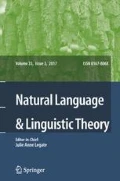Abstract
Two distinct ideas about how morphological case is assigned exist in the recent generative literature: the standard Chomskyan view that case is assigned by designated functional heads to the closest NP via an agreement relationship, and an alternative view in which case is assigned to one NP if there is a second NP in the same local domain (Marantz 1991). We claim that these two ways of assigning case are complementary, based on data from the Turkic language Sakha. Accusative case and dative case in this language are assigned by Marantz-style configurational rules that do not refer directly to functional categories. This is shown by evidence from passives, agentive nominalizations, subject raising, possessor raising, and case assignment in PPs. In contrast, there is evidence that nominative and genitive are assigned by functional heads in the Chomskyan way, as shown by the distribution of nominative case and the relationship between case marking and agreement. The two methods of case assignment thus coexist, not only in Universal Grammar, but even in the grammar of a single language.
Similar content being viewed by others
References
Aissen, Judith. 2003. Differential object marking: iconicity vs. economy. Natural Language & Linguistic Theory 21: 435–483.
Baker, Mark. 1988. Incorporation: a theory of grammatical function changing. Chicago: University of Chicago Press.
Baker, Mark. 2008. The syntax of agreement and concord. Cambridge: Cambridge University Press.
Baker, Mark. 2009a. When agreement is for number and gender but not for person. Manuscript, Rutgers University. http://www.rci.rutgers.edu/~mabaker/no-person-agr-paper.pdf.
Baker, Mark. 2009b. Degrees of nominalizations: clause-like constituents in Sakha. Manuscript, Rutgers University. http://www.rci.rutgers.edu/~mabaker/degrees-of-noml-sakha.pdf.
Baker, Mark, and Nadezhda Vinokurova. 2009. On agentive nominalizations and how they differ from event nominalizations. Language 85: 517–556.
Barss, Andrew, and Howard Lasnik. 1986. A note on anaphora and double objects. Linguistic Inquiry 17: 347–354.
Bittner, Maria, and Kenneth Hale. 1996. The structural determination of Case and agreement. Linguistic Inquiry 27: 1–68.
Bobaljik, Jonathan. 2008. Where’s Phi? Agreement as a post-syntactic operation. In Phi theory: phi features across interfaces and modules, eds. David Adger, Daniel Harbour, and Susanna Béjar, 295–328. Oxford: Oxford University Press.
Bobaljik, Jonathan, and Phil Branigan. 2006. Eccentric agreement and multiple case checking. In Ergativity: emerging issues, eds. Alana Johns, Diane Massam, and Juvenal Ndayiragije, 47–77. Dordrecht: Springer.
Chomsky, Noam. 1981. Lectures on government and binding. Dordrecht: Foris.
Chomsky, Noam. 2000. Minimalist inquiries: the framework. In Step by step, eds. Roger Martin, David Michaels, and Juan Uriagereka, 89–155. Cambridge: MIT Press.
Chomsky, Noam. 2001. Derivation by phase. In Ken Hale: a life in language, ed. Michael Kenstowicz, 1–52. Cambridge: MIT Press.
Collins, Chris. 2005. A smuggling approach to the passive in English. Syntax 8: 81–120.
Comrie, Bernard. 2005. Alignment of case marking of full noun phrases. In The world atlas of language structures, eds. Martin Haspelmath, Matthew Dryer, David Gil, and Bernard Comrie, 398–403. Oxford: Oxford University Press.
Diesing, Molly. 1992. Indefinites. Cambridge: MIT Press.
Emonds, Joseph. 1985. A unified theory of syntactic categories. Dordrecht: Foris.
Enç, Murvet. 1991. The semantics of specificity. Linguistic Inquiry 22:1–27.
Fox, Danny, and David Pesetsky. 2004. Cyclic linearization of syntactic structure. Theoretical Linguistics 31: 1–46.
George, Leland, and Jaklin Kornfilt. 1981. Finiteness and boundedness in Turkish. In Binding and filtering, ed. Frank Heny, 105–129. Cambridge: MIT Press.
Halle, Morris, and Alec Marantz. 1993. Distributed morphology and the pieces of inflection. In The view from building 20, eds. Kenneth Hale and Samuel J. Keyser, 111–176. Cambridge: MIT Press.
Kornfilt, Jaklin. 2005. Agreement and its placement in Turkic nonsubject relative clauses. In The Oxford handbook of comparative syntax, eds. Guglielmo Cinque and Richard Kayne, 513–541. New York: Oxford University Press.
Kornfilt, Jaklin. 2010. Subject case and Agr in two types of Turkic RCs. Paper presented at WAFL 4, 18–20 May 2007, Cambridge, MA.
Krause, Cornelia. 2001. On reduced relatives with genitive subjects. Cambridge, MA: MIT dissertation.
Krueger, John. 1962. Yakut manual. Bloomington: Indiana University Publications.
Larson, Richard. 1988. On the double object construction. Linguistic Inquiry 19: 335–392.
Lavine, James, and Steven Franks. 2008. On accusative first. In Formal Approaches to Slavic Linguistics 16, eds. Andrei Antonenko, John F. Bailyn, and Christina Y. Bethin, 231–247. Ann Arbor: Michigan Slavic Publications.
Lefebvre, Claire, and Pieter Muysken. 1988. Mixed categories: nominalizations in Quechua. Kluwer: Dordrecht.
Legate, Julie. 2003. Some interface properties of the phase. Linguistic Inquiry 34: 506–516.
Legate, Julie. 2008. Morphological and abstract case. Linguistic Inquiry 39: 55–102.
Marantz, Alec. 1991. Case and licensing. In ESCOL ’91: proceedings of the eighth eastern states conference on linguistics, 234–253.
McFadden, Thomas. 2004. The position of morphological case in the derivation. Philadelphia, PA: UPenn dissertation.
Mohanan, Tara. 1995. Woodhood and lexicality: noun incorporation in Hindi. Natural Language & Linguistic Theory 13: 75–134.
Moore, John. 1998. Turkish copy-raising and A-chain locality. Natural Language & Linguistic Theory 16: 149–189.
Nichols, Johanna. 1986. Head-marking and dependent-marking grammar. Language 62: 56–119.
Reinhart, Tanya, and Tal Siloni. 2005. The lexicon-syntax parameter: reflexivization and other arity operations. Linguistic Inquiry 36: 389–436.
Şener, Serkan. 2010. Non-canonical case marking is canonical: accusative subjects in Turkish. Natural Language & Linguistic Theory (to appear).
Siewierska, Anna. 2005. Verbal person marking. In The world atlas of language structures, eds. Martin Haspelmath, Matthew Dryer, David Gil, and Bernard Comrie, 414–417. Oxford: Oxford University Press.
Stachowski, Marek, and Astrid Menz. 1998. Yakut. In The Turkic languages, eds. Lars Johanson and Eva Csató, 417–433. London: Routledge.
Stowell, Timothy. 1981. Origins of phrase structure. Cambridge: MIT dissertation.
Vinokurova, Nadezhda. 2005. Lexical categories and argument structure: a study with reference to Sakha. Utrecht, NL: University of Utrecht dissertation.
Woolford, Ellen. 1997. Four-way case systems: ergative, nominative, objective, and accusative. Natural Language & Linguistic Theory 15: 181–227.
Yip, Moira, Maling Joan, and Ray Jackendoff. 1987. Case in tiers. Language 63: 217–250.
Author information
Authors and Affiliations
Corresponding author
Rights and permissions
About this article
Cite this article
Baker, M.C., Vinokurova, N. Two modalities of case assignment: case in Sakha. Nat Lang Linguist Theory 28, 593–642 (2010). https://doi.org/10.1007/s11049-010-9105-1
Received:
Accepted:
Published:
Issue Date:
DOI: https://doi.org/10.1007/s11049-010-9105-1




